 The impact of Covid-19 on businesses has left business leaders in a search for strategies to understand and anticipate possible disruptions to the business environment and how to prepare effectively and successfully sail through uncertainties in the future. Thus, to determine the future, especially within a business environment, scenario planning and forecasting are used to predict and prepare for what may happen in the future. Even though these terms are sometimes used interchangeably, they are different techniques with different meanings.
The impact of Covid-19 on businesses has left business leaders in a search for strategies to understand and anticipate possible disruptions to the business environment and how to prepare effectively and successfully sail through uncertainties in the future. Thus, to determine the future, especially within a business environment, scenario planning and forecasting are used to predict and prepare for what may happen in the future. Even though these terms are sometimes used interchangeably, they are different techniques with different meanings.
Scenario planning involves the identification of different possible paths that could lead to the future, taking into consideration the changing market conditions. Scenario-based planning is a process of decision-making widely used by professionals and decision-makers to plan and respond dynamically to an unknown future. Thus, scenarios planning provides a coherent and credible alternative about the future (Cornelius et al., 2005). With scenarios, decision-makers can think and plan on the different ways the future could unfold and how they can respond effectively and be resilient as the future becomes a reality. Thus, scenario-based planning offers flexibility in dealing with risk and uncertainties towards multiple possible futures, thereby relying on a few scenarios to study uncertainty surrounding decisions made about the future using qualitative or quantitative methods (Dean, 2019). As a result, scenario planning requires enormous time and resources. It is a collaborative process involving different groups of people within an organization with creative thinking abilities to determine the possible routes the future could lead to, thereby creating multiple long-term futures based on unknown risks and uncertainties. The value of scenario planning is realizable in a range of features or possible outcomes rather than the ability to predict a particular future outcome (Dean, 2019).
 On the other hand, traditional forecasting uses historical observations to estimate future business metrics such as budgets, revenue, and performance. Forecasts provide the best estimate when using a particular method, plan, action, or technique to achieve maximum benefits of a particular outcome; thus, it is a less creative process that does not anticipate deviations, risks, and uncertainties within the business environment (Dean, 2019). However, forecasting could help businesses conduct a potential future impact, such as determining the size of a market for a new product and predicting the market share based on current purchasing power (Taylor & Letham, 2018). However, this prediction does not consider uncertainties that may arise in the future, which may thwart the forecasted outcome. Forecasts are made on the assumption that the world in the future looks much like it is today and uses a quantitative methodology in predicting what will or what should happen in the future by interpreting the trends in historical data (Cornelius et al., 2005). This predictive feature of forecasting assumes the future will be similar to the past; thus, when applied to uncertain environments where the future is different from the past, the forecast is bound to fail. Thus, forecasting is a short-term tool used to determine the uncertainty in a singular metric’s future based on known variables. This ideology in forecasting makes it susceptible to failure because the past may not necessarily represent the uncertainties in the future.
On the other hand, traditional forecasting uses historical observations to estimate future business metrics such as budgets, revenue, and performance. Forecasts provide the best estimate when using a particular method, plan, action, or technique to achieve maximum benefits of a particular outcome; thus, it is a less creative process that does not anticipate deviations, risks, and uncertainties within the business environment (Dean, 2019). However, forecasting could help businesses conduct a potential future impact, such as determining the size of a market for a new product and predicting the market share based on current purchasing power (Taylor & Letham, 2018). However, this prediction does not consider uncertainties that may arise in the future, which may thwart the forecasted outcome. Forecasts are made on the assumption that the world in the future looks much like it is today and uses a quantitative methodology in predicting what will or what should happen in the future by interpreting the trends in historical data (Cornelius et al., 2005). This predictive feature of forecasting assumes the future will be similar to the past; thus, when applied to uncertain environments where the future is different from the past, the forecast is bound to fail. Thus, forecasting is a short-term tool used to determine the uncertainty in a singular metric’s future based on known variables. This ideology in forecasting makes it susceptible to failure because the past may not necessarily represent the uncertainties in the future.
Despite the pros and cons of both scenario planning and traditional forecasting, scenario planning is a superior and more strategic technique for predicting the future because it considers possible risks and uncertainties. Scenario planning offers flexibility and preparedness with the combination of quantitative and qualitative methodologies rather than a pure quantitative forecasting model. While forecast offers one possible future, scenarios offer multiple possible futures considering uncertainties and risks. However, the two techniques could be used to complement each other to predict the future.
References
Cornelius, P., Van de Putte, A., & Romani, M. (2005). Three Decades of Scenario Planning in Shell [Article]. California Management Review, 48(1), 92-109. https://doi.org/10.2307/41166329
Dean, M. (2019). Scenario planning: A literature review. A report of project(769276-2). https://www.academia.edu/43649617/Scenario_Planning_A_Literature_Review?email_work_card=reading-history
Taylor, S. J., & Letham, B. (2018). Forecasting at scale. The American Statistician, 72(1), 37-45. https://www.tandfonline.com/doi/abs/10.1080/00031305.2017.1380080
-
Mavis Ofehttps://eyongesttech.com/author/admin-eygtech/
-
Mavis Ofehttps://eyongesttech.com/author/admin-eygtech/
-
Mavis Ofehttps://eyongesttech.com/author/admin-eygtech/
-
Mavis Ofehttps://eyongesttech.com/author/admin-eygtech/


